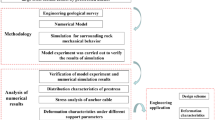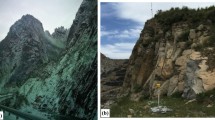Abstract
As a typical and complex failure type of rock slopes, flexural toppling failure has increasingly received attention, mainly focused on its failure mechanism and introducing a proper numerical method to reproduce the failure phenomena. However, there are few studies related to the supporting mechanism against flexural toppling failure. This study attempted to make a preliminary analysis on the research gap. For this purpose, an anti-dip layered rock slope supported with anchor cables that failed owning to flexural toppling was taken as an example, and the numerical method discontinuous deformation analysis (DDA) was taken as the major analytical tool. Firstly, the rationality of DDA was verified by correctly simulating the failure state of the anti-layered rock slope and the underlying failure mechanism was studied. The results indicated that the lack of the support from slope toe is the crucial factor inducing the flexural toppling failure, which posed a great obstacle to the further excavation of the open-pit mine. Secondly, by introducing the anchor cable support to the slope toe in the DDA model, the interaction mechanism between the anchor cables and the rock slope was investigated. the results indicated that the supporting system of the ordinary anchor cables is very sensitive to the inhomogeneous flexural toppling deformation. The tension values of the anchor cables are very inhomogeneous, and once some of anchor cables beyond their tension limit, the anchor cables failed, which will greatly threaten the safety of the adjacent anchor cables and even the stability of the whole slope. Meanwhile, a novel anchor cable called constant-resistance-large-deformation (CRLD) anchor cable was introduced for a comparative study using DDA. just replacing the anchor cables of the original slope with the CRLD anchor cables, the slope can reach stable state eventually even without the slope toe being enhanced. In addition, the CRLD anchor cables were able to support the slope well against the inhomogeneous deformation, because they can provide high constant resistances and withstand large deformations. This study can provide a deeper insight into the support mechanism for the snit-layered rock slope against flexural toppling failure and introduce a novel supporting method for such slopes.
Similar content being viewed by others
References
Adhikary DP, Dyskin AV, Jewell RJ (1996) Numerical modeling of the flexural deformation of foliated rock slopes. International Journal of Rock Mechanics & Mining Sciences 33(6):595–606, DOI: https://doi.org/10.1016/0148-9062(96)00008-3
Adhikary DP, Dyskin AV, Jewell RJ, Stewart DP (1997) A study of the mechanism of flexural toppling failure of rock slopes. Rock Mechanics and Rock Engineering 30(2):75–93, DOI: https://doi.org/10.1007/bf01020126
Alzoubi AK, Martin CD, Cruden DM (2010) Influence of tensile strength on toppling failure in centrifuge tests. International Journal of Rock Mechanics & Minning Sciences 47:974–982, DOI: https://doi.org/10.1016/j.ijrmms.2010.05.011
Aydan O, Kawamoto T (1992) The stability of slopes and underground openings against flexural toppling and their stabilization. Rock Mechanics and Rock Engineering 25(3):143–165, DOI: https://doi.org/10.1007/BF01019709
Aydan O, Kyoya T, Ichikawa Y, Kawamoto T (1988) flexural toppling failures in slopes and underground openings. Proceedings of 9th West Japan Symp., Rock Engineering, Kumamoto, Japan
Chen ZY, Gong WJ, Ma GW, Wang J, He L, Xing YC, Xing JY (2015) Comparisons between centrifuge and numerical modeling results for slope toppling failure. Science China Technological Sciences 58(9): 1497–1508, DOI: https://doi.org/10.1007/s11431-015-5889-x
Chen ZY, Zhang JH, Wang WX, Xing YC (2006) Centrifuge modeling for rock slopes. Proceedings of 6th International Conference Physical Modeling Geotechnics, Taylor & Francis Group, Hong Kong
Cundall PA (1971) A computer model for simulating progressive, large-scale movements in blocky rock systems. Proceedings of the symposium on international society for rock mechanics, Nancy, France
Doolin DM, Sitar N (2002) Displacement accuracy of discontinuous deformation analysis method applied to sliding block. Journal of Engineering Mechanics 128(11):1158–1168, DOI: https://doi.org/10.1061/(ASCE)0733-9399(2002)128:11(1158)
Fu XD, Sheng Q, Zhang YH, Chen J (2015) Investigations of the sequential excavation and reinforcement of an underground cavern complex using the discontinuous deformation analysis method. Tunneling and Underground Space Technology 50:79–93, DOI: https://doi.org/10.1016/j.tust.2015.06.010
GB 50021-2001 (2001) Code for investigation of geotechnical engineering. China Architecture & Building Press, Beijing, China
GB 51016-2014 (2014) Technical code for non-coal open-pit mine slope engineering, China Planning Press, Beijing, China
Goodman RE (2013) Toppling — A fundamental failure mode in discontinuous materials—Description and Analysis. Geo-Congress 2013: Stability and Performance of Slopes and Embankments III, ASCE, California, United States
Goodman RE, Bray JW (1976) Toppling of rock slopes. Proceedings of the ASCE conference on rock engineering for foundations and slopes, ASCE, Boulder, Colorado, United States
He MC, Gong WL, Wang J, Peng Q, Tao ZG, Du S, Peng YY (2014a) Development of a novel energy-absorbing bolt with extraordinarily large elongation and constant resistance. International Journal of Rock Mechanics and Mining Sciences 67:29–42, DOI: https://doi.org/10.1016/j.ijrmms.2014.01.007
He MC, Li C, Gong WL, Sousa LR, Li SL (2017) Dynamic tests for a Constant-Resistance-Large-Deformation bolt using a modified SHTB system. Tunnelling and Underground Space Technology 64:103–116, DOI: https://doi.org/10.1016/j.tust.2016.12.007
He MC, Li C, Gong WL, Wang J, Tao ZG (2016) Support principles of NPR bolts/cables and control techniques of large deformation. Chinese Journal of Rock Mechanics and Engineering 35(8):1513–1529, DOI: https://doi.org/10.13722/j.cnki.jrme.2015.1246
He MC, Wang J, Sun XM, Yang XJ (2014b) Mechanics characteristics and application of prevention and control rock burst of the negative poisson’s ratio effect anchor. Journal of China Coal Society 39(2): 214–221, DOI: https://doi.org/10.13225/j.cnki.jccs.2013.2022
Hitting M (1979) Numerical analysis of toppling failures in jointed rock. PhD Thesis, University of California, Berkeley, United States
Jing L (2003) A review of techniques, advances and outstanding issues in numerical modeling for rock mechanics and rock engineering. International Journal of Rock Mechanics & Mining Sciences 40(3): 283–353, DOI: https://doi.org/10.1016/S1365-1609(03)00013-3
Li CC (2010) Field observations of rock bolts in high stress rock masses. Rock Mech Rock Eng. 43:491–496, DOI: https://doi.org/10.1007/s00603-009-0067-8
Lian JJ, Li Q, Deng XF, Zhao GF, Chen ZY (2018) A numerical study on toppling failure of a jointed rock slope by using the distinct lattice spring model. Rock Mechanics and Rock Engineering 51(3):1–18, DOI: https://doi.org/10.1007/s00603-017-1323-y
Maclaughlin MM, Doolin DM (2006) Review of validation of the discontinuous deformation analysis (DDA) method. International Journal for Numerical and Analytical Methods in Geomechanics 30:271–305, DOI: https://doi.org/10.1002/nag.427
Majdi A, Amini M (2011) Analysis of geo-structural defects in flexural toppling failure. International Journal of Rock Mechanics & Mining Sciences 48(2):175–186, DOI: https://doi.org/10.1016/j.ijrmms.2010.11.007
Ning YJ, Yang J, An XM, Ma GW (2011) Modeling rock fracturing and blast-induced rock mass failure via advanced discretization within the discontinuous deformation analysis framework. Computers and Geotechnics 38(1):40–49, DOI: https://doi.org/10.1016/j.compgeo.2010.09.003
Prichard MA, Savigny KW (1990) Numerical modeling of toppling. Canadian Geotechnical Journal 27(6):823–834, DOI: https://doi.org/10.1139/t90-095
Rabczuk T, Belytschko T (2004) Cracking particles: A simplified meshfree method for arbitrary evolving cracks. International Journal for Numerical Methods in Engineering 61(13):2316–2343, DOI: https://doi.org/10.1002/nme.1151
Rabczuk T, Belytschko T (2007) A three-dimensional large deformation meshfree method for arbitrary evolving cracks. Computer Methods in Applied Mechanics and Engineering 196(29–30):2777–2799, DOI: https://doi.org/10.1016/j.cma.2006.06.020
Rabczuk T, Zi G, Bordas S, Nguyen-Xuan H (2010) A simple and robust three-dimensional cracking-particle method without enrichment. Computer Methods in Applied Mechanics and Engineering 199(37–40):2437–2455, DOI: https://doi.org/10.1016/j.cma.2010.03.031
Ren HL, Zhuang XY, Cai YC, Rabczuk T (2016) Dual-horizon peridynamics. International Journal for Numerical Methods in Engineering 108(12):1451–1476, DOI: https://doi.org/10.1002/nme.5257
Ren HL, Zhuang XY, Rabczuk T (2017) Dual-horizon peridynamics: A stable solution to varying horizons. Computer Methods in Applied Mechanics and Engineering 318:762–782, DOI: https://doi.org/10.1016/j.cma.2016.12.031
Shi GH (1988) Discontinuous deformation analysis-A new model for the statics and dynamics of block systems. PhD Thesis, University of California, Berkeley, California, United States
Wyllie DC (1980) Toppling rock slope failures examples of analysis and stabilization. Rock Mechanics and Rock Engineering 13:89–98, DOI: https://doi.org/10.1007/BF01238952
Yeung MCR (1991) Application of Shi’s Discontinuous Deformation Analysis to the study of rock behavior. PhD Thesis, University of California, Berkeley, California, United States
Zhang JH, Chen ZY, Wang XG (2007) Centrifuge modeling of rock slopes susceptible to block toppling. Rock Mechanics and Rock Engineering 40(4):363–382, DOI: https://doi.org/10.1007/s00603-006-0112-9
Zhou SW, Rabczuk T, Zhuang XY (2018) Phase field modeling of quasi-static and dynamic crack propagation: COMSOL implementation and case studies. Advances in Engineering Software 122:31–49, DOI: https://doi.org/10.1016/j.advengsoft.2018.03.012
Zhou SW, Zhuang XY, Rabczuk T (2019a) Phase field modeling of brittle compressive-shear fractures in rock-like materials: A new driving force and a hybrid formulation. Computer Methods in Applied Mechanics and Engineering 355:729–752, DOI: https://doi.org/10.1016/j.cma.2019.06.021
Zhou SW, Zhuang XY, Rabczuk T (2019b) Phase-field modeling of fluid-driven dynamic cracking in porous media. Computer Methods in Applied Mechanics and Engineering 350:169–198, DOI: https://doi.org/10.1016/j.cma.2019.03.001
Acknowledgments
Not Applicable
Author information
Authors and Affiliations
Corresponding author
Rights and permissions
About this article
Cite this article
Gong, W.J., Tao, Z.G., He, M.C. et al. Feasibility Analysis on the Support of Rock Slopes Against Flexural Toppling Failure Using the DDA Method-A Case Study. KSCE J Civ Eng 26, 3847–3862 (2022). https://doi.org/10.1007/s12205-022-2331-3
Received:
Revised:
Accepted:
Published:
Issue Date:
DOI: https://doi.org/10.1007/s12205-022-2331-3




